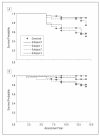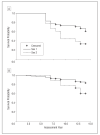Very early predictors of adolescent depression and suicide attempts in children with attention-deficit/hyperactivity disorder
- PMID: 20921120
- PMCID: PMC3382065
- DOI: 10.1001/archgenpsychiatry.2010.127
Very early predictors of adolescent depression and suicide attempts in children with attention-deficit/hyperactivity disorder
Abstract
Context: Major depression and dysthymia in adolescence are associated with substantial disability, need for mental health services, and risk for recurrence. Concrete suicidal ideation and attempts during adolescence are particularly associated with significant distress, morbidity, and risk for completed suicide.
Objectives: To test the hypothesis that young children with attention-deficit/hyperactivity disorder (ADHD) are at increased risk for depression and suicidal ideation and attempts during adolescence and to identify early predictors of which young children with ADHD are at greatest risk.
Design: Prospective follow-up study.
Setting: Chicago, Illinois, and Pittsburgh, Pennsylvania. Patients A cohort of 125 children who met DSM-IV criteria for ADHD at 4 to 6 years of age and 123 demographically matched comparison children without ADHD were prospectively followed up in 7 structured diagnostic assessments of depression and suicidal behavior in assessment years 6 through 14, spanning 9 through 18 years of age.
Main outcome measures: DSM-IV criteria for depressive disorders and suicidal behavior.
Results: Children with ADHD at 4 to 6 years of age were at greatly increased risk for meeting DSM-IV criteria for major depression or dysthymia (hazard ratio, 4.32) and for attempting suicide (hazard ratio, 3.60) through the age of 18 years relative to comparison children. There were marked variations in risk for these outcomes among children with ADHD, however. Within the ADHD group, children with each subtype of ADHD were at risk but for different adverse outcomes. Girls were at greater risk for depression and suicide attempts. Maternal depression and concurrent child emotional and behavior problems at 4 to 6 years of age predicted depression and suicidal behavior.
Conclusions: All subtypes of ADHD in young children robustly predict adolescent depression and/or suicide attempts 5 to 13 years later. Furthermore, female sex, maternal depression, and concurrent symptoms at 4 to 6 years of age predict which children with ADHD are at greatest risk for these adverse outcomes. Identifying high-risk young children with ADHD sets the stage for early prevention trials to reduce risk for later depression and suicidal behavior.
Figures




Comment in
-
Young children with ADHD are at increased risk of depression and suicidal behaviour in adolescence.Evid Based Ment Health. 2011 Feb;14(1):15. doi: 10.1136/ebmh.14.1.15. Evid Based Ment Health. 2011. PMID: 21266612 No abstract available.
References
-
- Barkley R, Murphy K, Kwasnik D. Psychological adjustment and adaptive impairments in young adults with ADHD. J Atten Disord. 1996;1:41–54.
-
- Biederman J, Faraone SV, Spencer T, Wilens T, Norman D, Lapey KA, Mick E, Lehman BK, Doyle A. Patterns of psychiatric comorbidity, cognition, and psychosocial functioning in adults with attention deficit hyperactivity disorder. Am J Psychiatry. 1993;150(12):1792–1798. - PubMed
-
- Murphy KR, Barkley RA, Bush T. Young adults with attention deficit hyperactivity disorder: subtype differences in comorbidity, educational, and clinical history. J Nerv Ment Dis. 2002;190(3):147–157. - PubMed
-
- Roy-Byrne P, Scheele L, Brinkley J, Ward N, Wiatrak C, Russo J, Townes B, Varley C. Adult attention-deficit hyperactivity disorder: assessment guidelines based on clinical presentation to a specialty clinic. Compr Psychiatry. 1997;38(3):133–140. - PubMed
-
- Shekim WO, Asarnow RF, Hess E, Zaucha K, Wheeler N. A clinical and demographic profile of a sample of adults with attention deficit hyperactivity disorder, residual state. Compr Psychiatry. 1990;31(5):416–425. - PubMed
Publication types
MeSH terms
Grants and funding
LinkOut - more resources
Full Text Sources
Medical
Miscellaneous

